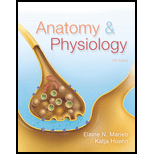
Anatomy & Physiology
5th Edition
ISBN: 9780321861580
Author: Marieb, Elaine N.
Publisher: Pearson College Div
expand_more
expand_more
format_list_bulleted
Textbook Question
Chapter 24, Problem 18CYU
A kidney stone blocking a ureter would interfere with urine flow to which organ? Why would the pain occur in waves?
Expert Solution & Answer
Trending nowThis is a popular solution!

Students have asked these similar questions
Generate one question that requires a Punnet Squre to solve the question. Then show how you calculate the possibilities of genotype and phenotype
Briefly state the physical meaning of the electrocapillary equation (Lippman equation).
Explain in a small summary how:
What genetic information can be obtained from a Punnet square? What genetic information cannot be determined from a Punnet square?
Why might a Punnet Square be beneficial to understanding genetics/inheritance?
Chapter 24 Solutions
Anatomy & Physiology
Ch. 24 - Roger is hit in the lower back by an errant...Ch. 24 - From inside to outside, list the three layers of...Ch. 24 - The lumen of the ureter is continuous with a space...Ch. 24 - Name the tubular components of a nephron in the...Ch. 24 - What are the structural differences between...Ch. 24 - What type of capillaries are the glomerular...Ch. 24 - Extrinsic and intrinsic controls of GFR serve two...Ch. 24 - Calculate net filtration pressure given the...Ch. 24 - Which of the pressures that determine NFP is...Ch. 24 - In which part of the nephron does most...
Ch. 24 - How are primary and secondary active transport...Ch. 24 - How does the movement of Na+ drive the...Ch. 24 - List several substances that are secreted into the...Ch. 24 - Describe the special characteristics of the...Ch. 24 - Under what conditions is ADH released from the...Ch. 24 - What would you expect the normal clearance value...Ch. 24 - What are the three major nitrogenous wastes...Ch. 24 - A kidney stone blocking a ureter would interfere...Ch. 24 - What is the trigone of the bladder, and which...Ch. 24 - Name the three regions of the male urethra.Ch. 24 - How does the detrusor respond to increased firing...Ch. 24 - The lowest blood concentration of nitrogenous...Ch. 24 - The glomerular capillaries differ from other...Ch. 24 - Damage to the renal medulla would interfere first...Ch. 24 - Which is reabsorbed by the proximal convoluted...Ch. 24 - Glucose is not normally found in the urine because...Ch. 24 - Filtration at the glomerulus is inversely related...Ch. 24 - Tubular reabsorption (a) of glucose and many other...Ch. 24 - If a freshly voided urine sample contains...Ch. 24 - Conditions such as diabetes mellitus and...Ch. 24 - Which of the following is/are true about ADH? (a)...Ch. 24 - What is the importance of the perirenal fat...Ch. 24 - Trace the pathway a creatinine molecule takes from...Ch. 24 - Explain the important differences between blood...Ch. 24 - Describe the mechanisms that contribute to renal...Ch. 24 - Prob. 15RQCh. 24 - Describe what is involved in active and passive...Ch. 24 - Explain how the peritubular capillaries are...Ch. 24 - Explain the process and purpose of tubular...Ch. 24 - How does aldosterone modify the chemical...Ch. 24 - Explain why the filtrate becomes hypotonic as it...Ch. 24 - How does urinary bladder anatomy support its...Ch. 24 - Define micturition and describe the micturition...Ch. 24 - Lets return to Kyle Boulard, whom we met in the...Ch. 24 - Lets return to Kyle Boulard, whom we met in the...Ch. 24 - Lets return to Kyle Boulard, whom we met in the...Ch. 24 - Lets return to Kyle Boulard, whom we met in the...Ch. 24 - Lets return to Kyle Boulard, whom we met in the...Ch. 24 - Lets return to Kyle Boulard, whom we met in the...Ch. 24 - Lets return to Kyle Boulard, whom we met in the...
Knowledge Booster
Learn more about
Need a deep-dive on the concept behind this application? Look no further. Learn more about this topic, biology and related others by exploring similar questions and additional content below.Similar questions
- In a small summary write down:arrow_forwardNot part of a graded assignment, from a past midtermarrow_forwardNoggin mutation: The mouse, one of the phenotypic consequences of Noggin mutationis mispatterning of the spinal cord, in the posterior region of the mouse embryo, suchthat in the hindlimb region the more ventral fates are lost, and the dorsal Pax3 domain isexpanded. (this experiment is not in the lectures).a. Hypothesis for why: What would be your hypothesis for why the ventral fatesare lost and dorsal fates expanded? Include in your answer the words notochord,BMP, SHH and either (or both of) surface ectoderm or lateral plate mesodermarrow_forward
arrow_back_ios
SEE MORE QUESTIONS
arrow_forward_ios
Recommended textbooks for you
 Human Physiology: From Cells to Systems (MindTap ...BiologyISBN:9781285866932Author:Lauralee SherwoodPublisher:Cengage Learning
Human Physiology: From Cells to Systems (MindTap ...BiologyISBN:9781285866932Author:Lauralee SherwoodPublisher:Cengage Learning Biology 2eBiologyISBN:9781947172517Author:Matthew Douglas, Jung Choi, Mary Ann ClarkPublisher:OpenStax
Biology 2eBiologyISBN:9781947172517Author:Matthew Douglas, Jung Choi, Mary Ann ClarkPublisher:OpenStax

Human Physiology: From Cells to Systems (MindTap ...
Biology
ISBN:9781285866932
Author:Lauralee Sherwood
Publisher:Cengage Learning





Biology 2e
Biology
ISBN:9781947172517
Author:Matthew Douglas, Jung Choi, Mary Ann Clark
Publisher:OpenStax
Excretory System; Author: Amoeba Sisters;https://www.youtube.com/watch?v=q5qaGHfdmYM;License: Standard youtube license